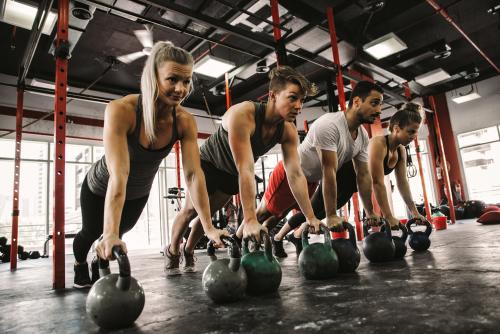Examining the Benefits of Resistance versus Weight Training
If you are someone who hasn’t integrated some sort of weight-based training into your fitness routine, you could be missing out on some pretty critical health benefits.
People who lift weights regularly or use their own body weight during exercise are leaner, burn more calories, have greater bone density (which is important as we age!), have a healthier blood pressure level, and report higher energy levels and better mood (Iladies, 2019). It can also help improve your sleep.
If you’re an older adult, strength training is even more important because it helps ward off chronic diseases like osteoporosis and osteopenia, diabetes, arthritis, and more (Seguin & Nelson, 2003).
Before you embark on a new fitness journey, make sure to consult with your physician, especially if you are above the age of 40 and haven’t been active recently. Warming up before your workout is very important to ensure you protect yourself from injury. An appropriate warmup could include stretching, leg lifts, or a brisk walk.
What is Strength Training?

There are a few different types of strength training, and you can do the exercises in the gym, fitness studio, at home or outside. These include body weight exercises, resistance tubing, free weights, and weight machines.
When you exercise using your own body weight as resistance, you strengthen your muscles with little to no equipment. Examples of body weight exercises include squats, planks, pushups, pull-ups and donkey kicks. There are a variety of apps and guides available online or in fitness magazines that provide information about body weight routines. You can build up your stamina by holding a plank 30 seconds longer than you normally would, or fitting in a couple more sets of pushups until you reach your goal.
You can use resistance tubes, loops or bands to strengthen various body parts such as your legs, arms, back, chest, core, and buttocks. These bands are made of stretchy elastic. They use constant tension to stimulate muscle growth in a controlled setting that is safe on joints. In addition, they can help you increase your flexibility, mobility and strength. Another benefit of these tools is that they are typically low cost, can be used virtually anywhere, and are portable so they can be used when you are traveling, for example. Exercise bands loop around the body part you would like to work, such as your legs, and use resistance to help you feel the burn. Resistance tubes also help you accomplish the same goal, but are circular in construction, rather than a band. Some tubes also contain hooks or loops that you can clip against a doorframe or around a solid object in the home. You can purchase these bands at big box stores, sporting stores, and from online retailers. There are a variety of styles and types to choose from, and they are relatively inexpensive, so you can try multiple types until you find the one that works best for you. There are even fitness classes designed around the use of resistance bands, such as TRX classes in which you use what they call “suspension training [that] provides muscular and cardiovascular benefits that can amount to a tremendous impact on an individual’s overall health” (Why TRX.com, n.d.). For the times in which you don’t have access to resistance bands, you can use things you already have around the house such as a towel. In fact, there are entire workout routines designed around the use of a towel that are available online and on video streaming sites like YouTube.
Bottesch echoes this sentiment. “Strength training or resistance training can be performed anywhere! All you need is your body weight and gravity,” she said. “Although some simple equipment is always great to have so that you can increase your load and vary some of the exercises you perform. We suggest to our clients that they invest in a simple set of dumbbells and some resistance bands for at-home strength training sessions. Body weight exercises include things like squats, lunges, step-ups, chair dips, push-ups, and a variety of core exercises. Adding resistance bands and dumbbells to the mix will increase the variety of your exercise choices.”
Free weights are a popular choice and a common fixture at most gyms and fitness studios. Using free weights allows you to work multiple muscle groups at one time because you’re doing compound movements. By doing compound movements, you are engaging several muscle groups at one time, so in that way you are being quite efficient. Many types of fitness classes also incorporate the use of free weights, such as barre, cycling, and boot camp-style classes. If you are working out at home or on the go and don’t have access to free weights, you can use household items like soup cans. Again, a little bit of creativity and resourcefulness can go a long way.
Finally, weight machines provide a different type of workout, and allow you to work one or multiple muscle groups during the same session. Most gyms have different weight machines to choose from, and trainers or gym employees can help beginners get the hang of how to use them properly. When in doubt, ask someone to help you in order to avoid misusing the machine or risking injury. Popular weight machines are highly visible fixtures in gyms and include the bench press, leg press, leg curl, chest fly, and lateral pull-down machines. You can increase or decrease the amount of weight you are pulling or pushing with each machine. It is best to start with little or no weights at all so you can get a feel for using the machine safely and properly.
Physical Benefits of Strength Training
Engaging in strength training can bring about a host of positive health effects. Some exercisers focus solely on cardio, which is great for building and maintaining cardiovascular health. However, in order to reap the maximum benefits from your fitness routine, you will need to incorporate some weight-related activities into your workouts.
“Strength training is essential to the overall well-being of people at any age. As we’ve evolved into more sedentary jobs and lifestyles, routine strength training becomes increasingly more important to offset the negative health consequences that result from these factors,” said Scott Everson, who has been a personal trainer for 15 years and is owner of Busy Bee Fitness Experts located in Toronto. “Increasing our bone density, metabolism, mobility, and posture are key benefits of strength training that are prevalent to adults of any age.”
In addition, research shows that strength training can help you lose weight by allowing you to gain muscle, increase your metabolism, and lose fat (Westcott, 2016). In a study involving more than 1,600 individuals considered “beginners” at exercising, incorporating strength training into their routine yielded positive results. Participants were able to decrease their body fat from 28% to 25% by increasing their lean weight by around 3 pounds while decreasing their fat level by almost 4 pounds (Westcott, Winett, Annesi, Wojcik, Anderson & Madden, 2009).
In another study, researchers examined how resistance training affected the weight of obese children and adolescents. They found that the obese children and adolescents found it more motivational to emphasize resistance training exercises rather than harping on weight loss as the primary goal (Ten Hoor et al., 2016). By allowing them to use their inherent physical strengths, the researchers anticipated long-term changes in health behaviors and wright loss, as well as increased confidence levels.
Strength training can help with chronic disease management. Individuals who have rheumatoid arthritis can find a great deal of relief doing strength training, which experts have found to be an effective non-pharmacological treatment (Hakkinen, 2004). Not only can individuals with arthritis of the hand increase their overall fitness, but they can also increase their gripping abilities and function while reducing hand pain (Rogers & Wilder, 2007).
For chronic disease management, strength training can also be very useful. When comparing a group of women who engage in strength training against a group of women who do not engage in any strength training, researchers found a reduction in risk of type 2 diabetes by 30% when controlling for confounding variables and time spent in other activities (Shiroma et al., 2017). The risk for cardiovascular disease is also lower for women engaging in strength training versus women who just engage in aerobic training.
Mental Health Benefits of Strength Training

Moving beyond the physical benefits, the mind-body connection we cultivate as part of exercise is so important, and research confirms this. Randomized controlled trials (the “gold standard” for research involving human participants) showed that adults who engage in strength training experience reductions in their anxiety and depression levels, as well as less low back pain, osteoarthritis, and fibromyalgia. Analysis of various research trials also showed adults had improved mental cognition and sleep quality (O’Conner, Herring, & Caravalho, 2010).
“Strength training, similar to cardiovascular exercise, has also been shown to improve mental health by decreasing feelings of depression and anxiety while improving self-image and mental toughness,” said Jessica Bottesch, co-owner of Empower Personalized Fitness and Empower Partners Coaching and Consulting, located in Durham, North Carolina. “As long as strength training is performed safely, for an appropriate duration, and at the right frequency (with built-in rest days), then there are very few cons to resistance training. There are certainly some contra-indications for strength training if you are injured or dealing with specific medical conditions. We at Empower Personalized Fitness highly recommend that individuals consult with a certified personal trainer to ensure they are following a program that is designed specifically based their health conditions, fitness level, and wellness goals,” she added.
Lifting weights can help you tap into your inner strength while you build your outer strength. For example, doing strength training on a regular basis can increase your energy levels. Exercise releases endorphins that increase our happiness and lower cortisol, also known as the stress hormone. A study involving patients with major depression showed that exercise is just as effective as antidepressant medications and psychotherapy for treating mile to moderate depression. For individuals with major depression, exercise serves as a useful complement to traditional treatments (Knapen, Vancampfort, Morien, & Marchal, 2014). These findings ring true for multiple age groups, such as older adults (Moraes et al, 2019).
Are you struggling to fall asleep, stay asleep, or get high-quality sleep? Perhaps all of the above? Engaging in regular strength training can help improve your sleep health and quality. In a research study involving 36 elderly males, the researchers randomly divided them into two groups – one group engaged in strength training three times per week for 12 weeks, and the other group was a control group. The results showed that the men in the strength-training group experienced significant improvement in their quality of sleep and psychomotor performance, which includes things like attention and speed processing (Irandoust & Taheri, 2018).
Finally, it’s important to note that strength training is for everyone – regardless of age.
“All people at all ages benefit from resistance exercise. It is the reason we emphasize ‘tummy time’ for infants – so that they can build the strength in their neck, shoulders and back. Resistance training is one of the best ways to keep yourself strong, mobile and independent later in life. Whether you are an extreme athlete or just want to be a healthy human, strength training is for you,” Bottesch added.
Repetitions vs. Weights
Is it best to do more repetitions (or reps) with a lower amount of weights, or to do fewer reps with a higher amount of weights? Expert opinions differ on this topic, but the simple answer is: it is best to mix and match both methods in order to achieve the best results when it comes to losing fat, building muscle, gaining strength and increasing overall fitness levels.
Research shows that you gain the most strength by lifting heavier weights and doing fewer reps (Shomaker & Theulen, 2017). Fitness experts and personal trainers agree.
“If the sole aim is to increase strength, we would typically recommend performing fewer repetitions at a higher weight,” Everson added.
By contrast, doing more reps but using less weight can effectively burn fat. Ideally, exercisers are engaging in both types of training in order to reap maximum benefits from their workouts, which include development of muscle fibers and growing them (Dowdell, n.d.). For guidelines on a full-body training session that incorporates higher weight and lower reps, plus lower weight and higher reps, click here.
How should you Design your Strength-Training Routine?
A major plus associated with strength and resistance training is that you are in control. You do not need fancy equipment, a gym or expensive tools. In fact, you can design your own routine that you can do in the comfort of your own home or hotel room when travelling.
To get started, you can design your own strength training routine with the aid of online tools and videos. Fitness magazines like Shape, Men’s Health, Women’s Health and others have a wealth of free training guides (and video tutorials) on their websites and social media platforms. The benefit of utilizing these platforms is that you can effectively vary your routine as often as you want when you feel that you are getting bored or plateauing and craving a new challenge.
If you prefer to work with an expert in person, you can consult with a personal trainer or fitness instructor to help you design a personalized routine tailored to your fitness and weight loss goals, age and lifestyle. Make sure to seek help from a certified personal trainer or someone who has legitimate and current certifications and/or licensure.
Most local gyms also offer classes that integrate strength and resistance training. These classes may include boot camp style, body pump, weight lifting and more.
How often should you engage in Strength Training?
Incorporating strength training into your existing fitness routine is easy. The American College of Sports Medicine recommends doing a 25-minute strength training circuit at least three days per week. These exercises include “weight stack resistance machines” like squat presses, leg curls, leg extensions, chest presses, seated row, shoulder presses, pulldowns, triceps presses, bicep curls, and abdominal crunches (Westcott, 2009).
Adults who do not engage in strength training are at a disadvantage when it comes to “beating” the natural aging process. For example, adults who do not strength train lose about four to six pounds of muscle tissue per decade (Westcott, 2009). This can lead to increases in fat.
The American Heart Association recommends strength training at least twice per week. They encourage people to start small, like doing simple, weight-bearing exercises that use your own body weight, free weights at the gym, or machines (American Heart Association, 2019).
Avoiding Injury
It is important to be mindful of injuries that can occur as a result of strength and resistance training, especially if you are a novice. Make sure to practice safe techniques when you are using weight machines, take precautions when picking up and putting down heavy weights like dumbbells, and do not overextend your body or pull muscles when using tools like resistance bands.
When you are embarking on a new fitness journey, checking in with yourself regularly is always a good idea. Ask yourself if you feel comfortable with the level of weights you are picking up, or if you need to scale them up or down. Don’t be afraid to adjust as you see fit to ensure you are still being challenged and safe at the same time.
If you are ever unsure about how to operate a machine or tool, consult a fitness expert like a personal trainer or fitness instructor at the gym.
Conclusion
Strength and resistance training are integral parts of maintaining a well-rounded fitness routine. Benefits include prevention (and management) of chronic disease such as diabetes, cardiovascular disease, fibromyalgia, and arthritis. This type of workout can help you lose weight and fat, and build up your strength, endurance and muscle mass. Going beyond the physical implications, strength training helps you cultivate a strong mind-body connection, and helps you build confidence. Individuals dealing with depression and anxiety can also find some relief in strength training. Finally, you can also positively impact your sleep quality by participating in this type of training.
Strength training is accessible, adaptable, inclusive, and easy to do. You can do it in the privacy of your own home, while you travel, in fitness classes and gyms. You do not need a lot of fancy equipment – instead, you can use your own body weight as resistance, or common household items like aluminum cans and towels. As you build up your confidence with strength training, you will feel better about your body and enjoy the mental health benefits of knowing you can set goals and achieve them.
By Nicki Karimipour, PhD
 Dr. Nicki Karimipour is a communications expert and experienced researcher. She obtained her master’s degree and Ph.D. in Health Communications from the University of Florida. She obtained her bachelor’s degrees from Florida State University.
Dr. Nicki Karimipour is a communications expert and experienced researcher. She obtained her master’s degree and Ph.D. in Health Communications from the University of Florida. She obtained her bachelor’s degrees from Florida State University.
Dr. Karimipour has previous experience in writing and editing for both print and online publications, and in teaching journalism, health writing, and public relations at the undergraduate and graduate level.
Her research-related experience ranges from collaborating with medical researchers and consulting on clinical trials, to clinical research program management. Her own research focuses on a variety of health topics, such as effects of social media use on female body image, football and concussions, and e-cigarette use among youth. Her research has been published in the Journal of Clinical and Translational Research, the Journal of Behavioral Health Services & Research, and the Journal of Sports Media.
She is based in Los Angeles, California and currently works at the University of Southern California in clinical trial operations. Follow her on Twitter: @NickiKPhD
References
Dowdell, J. (n.d.). Ask the Celebrity Trainer: High Reps and Light Weights vs. Low Reps and Heavy Weights. Shape.com. Retrieved from: https://www.shape.com/celebrities/star-trainers/ask-celebrity-trainer-high-reps-and-light-weights-vs-low-reps-and-heavy
Häkkinen, A. (2004). Effectiveness and safety of strength training in rheumatoid arthritis. Current Opinion in Rheumatology, 16(2), 132-137. Retrieved from: https://www.ncbi.nlm.nih.gov/pubmed/14770099
Iliades, C. (2019). 7 Ways Strength Training Boosts Your Health and Fitness. Everydayhealth.com. Retrieved from: https://www.everydayhealth.com/fitness/add-strength-training-to-your-workout.aspx
Irandoust, K. & Taheri, M. (2018). The Effect of Strength Training on Quality of Sleep and Psychomotor Performance in Elderly Males. Sleep and Hypnosis: A Journal of Clinical Neuroscience and Psychopathology, 20(3), 160-165. Retrieved from: https://pdfs.semanticscholar.org/9ead/3e145749c8187859c126c9cb901e03e77bcc.pdf
Knapen, J., Vancampfort, D., Morien, Y., & Marchal, Y. (2014). Exercise therapy improves both mental and physical health in patients with major depression. Disability and Rehabilitation, 37(16), 1490-1495. Retrieved from: https://www.tandfonline.com/doi/full/10.3109/09638288.2014.972579
Moraes, H.S., Silveira, H.S., Oliveira, N.A., Matta, E., Araújo, N.B., Vasques, P.E., Bergland, A., Santos, T.M., Engedal, K., Coutinho, E.S., Schuch, F.B., Laks, J., & Deslandes, A.C. (2019). Is Strength Training as Effective as Aerobic Training for Depression in Older Adults? A Randomized Controlled Trial. Retrieved from: https://www.karger.com/Article/Abstract/503750#
O’Connor, P.J., Herring, M.P., Caravalho, A. (2010). Mental Health Benefits of Strength Training in Adults. American Journal of Lifestyle Medicine, 4(5), 377-396. Retrieved from: https://journals.sagepub.com/doi/abs/10.1177/1559827610368771
Rogers, M.W. & Wilder, F.V. (2007). The Effects of Strength Training Among Persons with Hand Osteoarthritis: A Two-Year Follow-Up Study. Journal of Hand Therapy, 20(3), 244-250. Retrieved from: https://www.sciencedirect.com/science/article/pii/S0894113007000324
Seguin, R. & Nelson, M.E., (2003). The Benefits of Strength Training for Older Adults. American Journal of Preventive Medicine, 25(3), 141-149. Retrieved from: https://www.sciencedirect.com/science/article/pii/S0749379703001776
Shomaker, G. & Theulen, S. (2017). How Much Weight Should You Lift for Optimal Longevity? University of Colorado Boulder Healthy Aging Project. Retrieved from: https://healthyagingproject.org/2017/02/much-weight-lift-optimal-longevity/
Ten Hoor, G., Plasqui, G., Ruiter, R., Kremers, S., Rutten, G., Schols, A., & Kok, G. (2015). A New Direction in Psychology and Health: Resistance Exercise Training for Obese Children and Adolescents. Psychology & Health, 31(1), 1-8. Retrieved from: https://www.tandfonline.com/doi/full/10.1080/08870446.2015.1070158
Westcott, W. (2009). ACSM STRENGTH TRAINING GUIDELINES: Role in Body Composition and Health Enhancement. ACSM’S Health & Fitness Journal, 13(4), 14-22. Retrieved from: https://journals.lww.com/acsm-healthfitness/fulltext/2009/07000/ACSM_STRENGTH_TRAINING_GUIDELINES__Role_in_Body.7.aspx
Westcott, W. (2016). STRENGTH TRAINING FOR THOSE THAT NEED IT MOST. ACSM’S Health & Fitness Journal, 20(5), 23-28. Retrieved from: https://journals.lww.com/acsm-healthfitness/Fulltext/2016/09000/STRENGTH_TRAINING_FOR_THOSE_WHO_NEED_IT_MOST.8.aspx
Westcott, W., Winett, R., Annesi, J., Wojcik, J., Anderson, E., & Madden, P. (2009). Prescribing Physical Activity: Applying the ACSM Protocols for Exercise Type, Intensity, and Duration Across 3 Training Frequencies. The Physician and Sports Medicine, 37(2), 51-58. Retrieved from: https://www.ncbi.nlm.nih.gov/pubmed/20048509
Why TRX. (n.d.). Retrieved from https://www.trxtraining.com/why-trx
Frequently Asked Questions
What is weight training? Why is it important?
Weight training is an umbrella term which covers strength training activities involving weights as opposed to say, resistance bands or the weight of one's own body. Weights are a great way to add resistance to movements and thereby increase training intensity.
What is the main difference between cardio and strength-training activities?
Cardio training works more heavily the cardiovascular system involved in breathing whereas strength-training typically emphasizes the muscles more directly.
Should you do cardio or strength training first?
Whichever one you want to emphasize more heavily. If interested in strength gains, do cardio afterward. If interested in weight loss or cardio gains, consider incorporating the strength training into routine either during or after.
Do free weights or resistance machines build muscle faster?
Technically, the body doesn't know the difference between machines as it simply adapts to resistance. The training frequency, form, and resistance used will be the primary determinant.
Is resistance or weight training better for losing weight?
Resistance training affords one more opportunity to burn calories.
What are the disadvantages of resistance training?
Resistance training can be more time-consuming and potentially lead to more injuries. This can be handled with proper training and scheduling.



 Compact/Folding
Compact/Folding Front Drive
Front Drive Rear Drive
Rear Drive